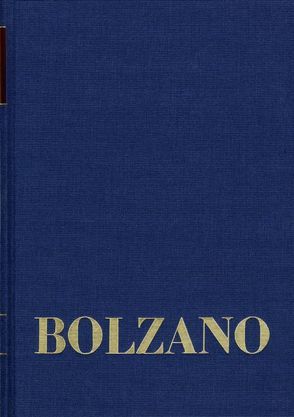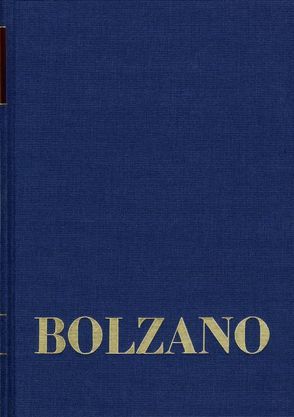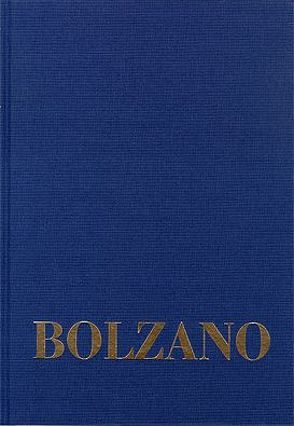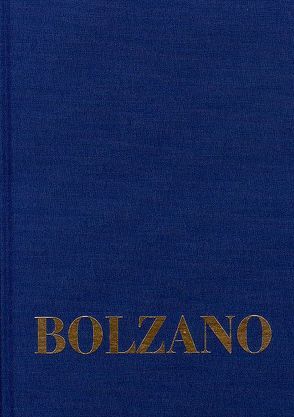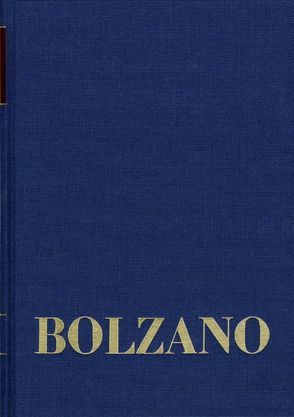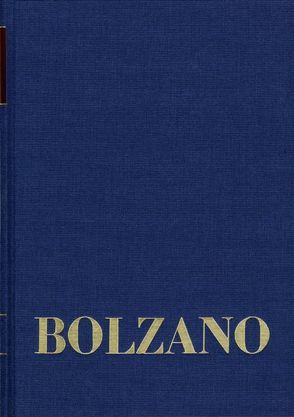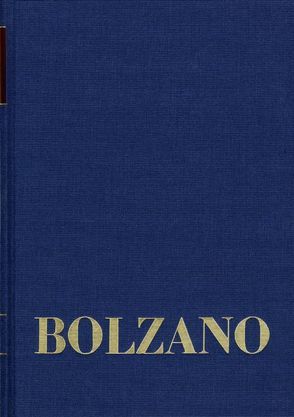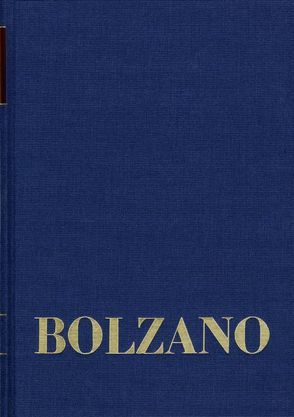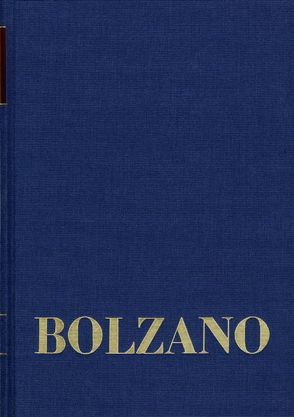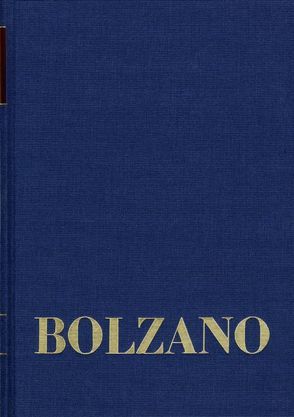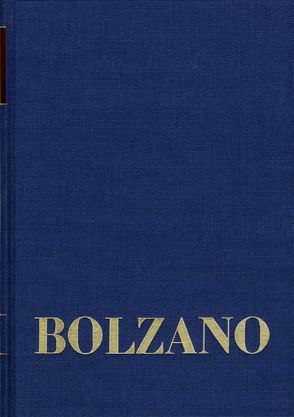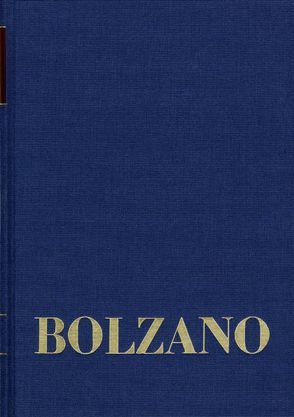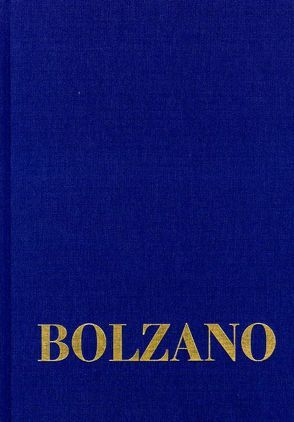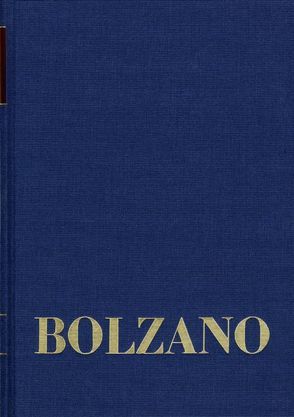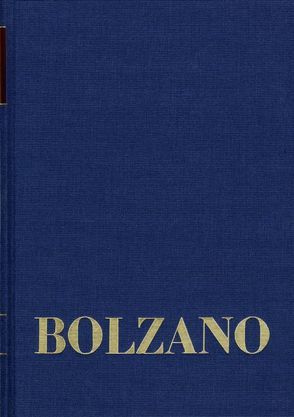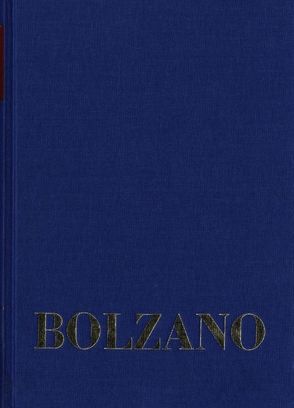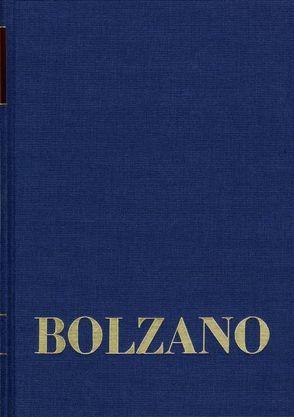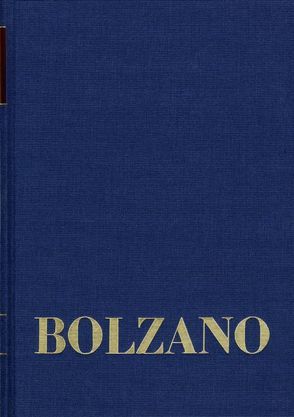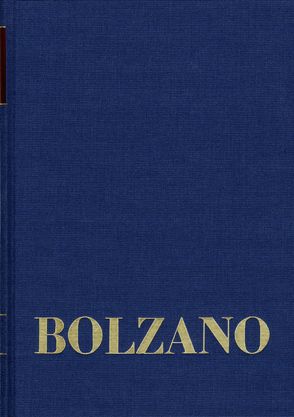
The notes of part 22 of the ‹Miscellanea Mathematica‹ were written between July of 1830 and August of 1832. Bolzano‹s natural philosophy of his later years was based on the assumption that the entire universe had a nuclear particle structure. Unlike the classic atomist, he believed that there was an atom at every point in space. Thus there is no vacuum. This means that no substance is isolated. This made him question the opposite view which he had expressed previously in the ‹Athanasia‹. His refutation in the second edition of the ‹Athanasia‹ is given in detail in the ‹Miscellanea Mathematica‹. At the beginning of the ‹Miscellanea Mathematica 22‹, he dealt with the definition of the concepts of space and time. According to Bolzano, the traditional definitions of the concepts of line, surface and solid were in need of improvement, and this induced him to give a detailed explanation. During the years of his reclusiveness after his dismissal in 1819 from his position as head of the department for religious studies at the University of Prague, Bolzano had been studying the logical foundations of mathematics and the foundations of logic. These studies were reflected in his theory of science. When he returned to pure mathematics after about a decade, he began work on a new encyclopedic work, the ‹Größenlehre‹, (Theory of Quantities). The notes in this volume contain a precisely structured plan of this work from the year 1831. In explaining the first arithmetical terms, Bolzano tries to avoid abstract terms. Some abstract terms are imaginary. Referring to contemporary scientific journals, he gives a report on imaginary and irrational quantities in the theory of numbers. On the basis of Legendre‹s discussion of Galois‹ problem of the solvability of algebraic equations, Bolzano suggests a simple method. He gives a detailed account of Gergonne‹s geometric treatment of Newton‹s method of finding the roots of a numerical equation by approximation and provides a counterexample for Fourier‹s assertion that a characteristic of the existence of the real roots of an equation also applies to transcendental roots. Furthermore he tries to find a simpler formulation of Cauchy‹s proof that each polynomial has a complex root. Bolzano studies the proof provided by several famous analytic theorems. He mentions Cauchy‹s simple and strict proof of Taylor‹s theorem and Crelle‹s attempt to expand this within the context of general theory of analytic functions. He studies Cauchy‹s theory of the infinite, examines several theorems and works his way around to the theory of tangency and discusses infinite series. There are no infinite large and small numbers, these terms are meaningless. The pivotal concepts of continuity and continuous functions are dealt with in several places. What is particularly remarkable is the discussion of the determinability of the functions. There was deemed to be a discrepancy between Bolzano‹s theory of functions and his paradoxes of the infinite. One way to eliminate this discrepancy would be to find an exact definition of the concept of determinability. A continuous function f is exactly determinable when the difference (x+∆x) –f(x) retains the same sign within certain values of x irregardless of how close they may be. Thus a determinable function is a continuous, piecewise monotonic function.
Aktualisiert: 2023-05-25
> findR *
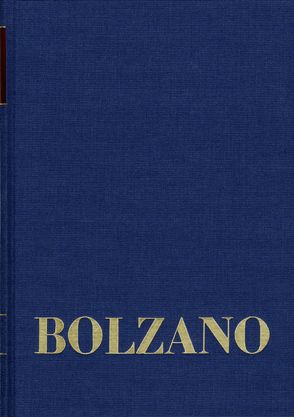
The notes of part 22 of the ‹Miscellanea Mathematica‹ were written between July of 1830 and August of 1832. Bolzano‹s natural philosophy of his later years was based on the assumption that the entire universe had a nuclear particle structure. Unlike the classic atomist, he believed that there was an atom at every point in space. Thus there is no vacuum. This means that no substance is isolated. This made him question the opposite view which he had expressed previously in the ‹Athanasia‹. His refutation in the second edition of the ‹Athanasia‹ is given in detail in the ‹Miscellanea Mathematica‹. At the beginning of the ‹Miscellanea Mathematica 22‹, he dealt with the definition of the concepts of space and time. According to Bolzano, the traditional definitions of the concepts of line, surface and solid were in need of improvement, and this induced him to give a detailed explanation. During the years of his reclusiveness after his dismissal in 1819 from his position as head of the department for religious studies at the University of Prague, Bolzano had been studying the logical foundations of mathematics and the foundations of logic. These studies were reflected in his theory of science. When he returned to pure mathematics after about a decade, he began work on a new encyclopedic work, the ‹Größenlehre‹, (Theory of Quantities). The notes in this volume contain a precisely structured plan of this work from the year 1831. In explaining the first arithmetical terms, Bolzano tries to avoid abstract terms. Some abstract terms are imaginary. Referring to contemporary scientific journals, he gives a report on imaginary and irrational quantities in the theory of numbers. On the basis of Legendre‹s discussion of Galois‹ problem of the solvability of algebraic equations, Bolzano suggests a simple method. He gives a detailed account of Gergonne‹s geometric treatment of Newton‹s method of finding the roots of a numerical equation by approximation and provides a counterexample for Fourier‹s assertion that a characteristic of the existence of the real roots of an equation also applies to transcendental roots. Furthermore he tries to find a simpler formulation of Cauchy‹s proof that each polynomial has a complex root. Bolzano studies the proof provided by several famous analytic theorems. He mentions Cauchy‹s simple and strict proof of Taylor‹s theorem and Crelle‹s attempt to expand this within the context of general theory of analytic functions. He studies Cauchy‹s theory of the infinite, examines several theorems and works his way around to the theory of tangency and discusses infinite series. There are no infinite large and small numbers, these terms are meaningless. The pivotal concepts of continuity and continuous functions are dealt with in several places. What is particularly remarkable is the discussion of the determinability of the functions. There was deemed to be a discrepancy between Bolzano‹s theory of functions and his paradoxes of the infinite. One way to eliminate this discrepancy would be to find an exact definition of the concept of determinability. A continuous function f is exactly determinable when the difference (x+∆x) –f(x) retains the same sign within certain values of x irregardless of how close they may be. Thus a determinable function is a continuous, piecewise monotonic function.
Aktualisiert: 2022-11-10
> findR *
On more than two thousand closely written folios, Bolzano‹s ‹Mathematical Diaries‹ provide a complete account of his scientific development between 1799 and 1844. Using this authentic account, it is possible to date Bolzano‹s most significant discoveries in mathematics and logic and to reveal his sources which were often almost inaccessible. Furthermore, these records contain supplements to those works already published and to his completed unpublished works.
Aktualisiert: 2022-08-18
> findR *
On more than two thousand closely written folios, Bolzano‹s ‹Mathematical Diaries‹ provide a complete account of his scientific development between 1799 and 1844. Using this authentic account, it is possible to date Bolzano‹s most significant discoveries in mathematics and logic and to reveal his sources which were often almost inaccessible. Furthermore, these records contain supplements to those works already published and to his completed unpublished works.
Aktualisiert: 2022-08-18
> findR *
In this comprehensive diary from 1820-1821 Bolzano deals with the concept of a consistency of a function and with questions pertaining to differential calculus, for example commutativity theorems of differentiation with functions of several variables. In mechanics, he attempts to determine the mean force of two forces acting in the same direction by means of functional equations which are accounted for by mechanical considerations. He does a detailed calculation of ovals composed of arcs which come closest to an ellipse.
Aktualisiert: 2022-08-18
> findR *
Heft 18 der Miscellanea Mathematica aus dem Jahr 1820 widmet sich hauptsächlich der Sammlung von Material zum geplanten umfassenden Lehrbuch der Mathematik. Dieses Lehrbuch war auf zwei Teile angelegt: die Größenlehre und die Raumwissenschaft (Geometrie). Die Hauptthemen sind die Summierung von trigonometrischen Reihen, arithmetischen Reihen höherer Ordnung, die analytische Definition der goniometrischen Funktionen und die Darstellung von ebenen algebraischen Kurven und Raumkurven auf quadratischen Flächen. Zusätzlich findet der Leser auch aufschlußreiche Anmerkungen Bolzanos zur Physik. Ebenfalls hervorzuheben sind Bolzanos Bemerkungen zur Rezension seiner Arbeit "Die drey Probleme" in der Haller allgemeinen Literaturzeitung von 1819.
Aktualisiert: 2022-08-18
> findR *
On more than two thousand closely written folios, Bolzano‹s ‹Mathematical Diaries‹ provide a complete account of his scientific development between 1799 and 1844. Using this authentic account, it is possible to date Bolzano‹s most significant discoveries in mathematics and logic and to reveal his sources which were often almost inaccessible. Furthermore, these records contain supplements to those works already published and to his completed unpublished works.
Aktualisiert: 2022-08-18
> findR *
On more than two thousand closely written folios, Bolzano‹s ‹Mathematical Diaries‹ provide a complete account of his scientific development between 1799 and 1844. Using this authentic account, it is possible to date Bolzano‹s most significant discoveries in mathematics and logic and to reveal his sources which were often almost inaccessible. Furthermore, these records contain supplements to those works already published and to his completed unpublished works.
Aktualisiert: 2022-08-18
> findR *
On more than two thousand closely written folios, Bolzano‹s ‹Mathematical Diaries‹ provide a complete account of his scientific development between 1799 and 1844. Using this authentic account, it is possible to date Bolzano‹s most significant discoveries in mathematics and logic and to reveal his sources which were often almost inaccessible. Furthermore, these records contain supplements to those works already published and to his completed unpublished works.
Aktualisiert: 2022-08-18
> findR *
On more than two thousand closely written folios, Bolzano‹s ‹Mathematical Diaries‹ provide a complete account of his scientific development between 1799 and 1844. Using this authentic account, it is possible to date Bolzano‹s most significant discoveries in mathematics and logic and to reveal his sources which were often almost inaccessible. Furthermore, these records contain supplements to those works already published and to his completed unpublished works.
Aktualisiert: 2022-08-18
> findR *
The manuscript ‹Zur Physik‹ (On Physics), which is part of Bolzano‹s literary estate kept in Prague, deals mainly with problems of natural philosophy. These include questions from the field of general physics, acoustics, optics, electricity,magnetism and gravitation, thermodynamics, biology, the history of the earth as well as new achievements in the area of technical-scientific instruments. Bolzano comments on the achievements of his contemporaries such as Ampère, Avogadro, Berzelius, Carnot, Faraday, Fries, Herbart, Herschel, Osann, Poisson or Wilhelm Eduard Weber. This manuscript shows that Bolzano was on the way to developing his own natural philosophy.
Aktualisiert: 2022-08-18
> findR *
On more than two thousand closely written folios, Bolzano‹s ‹Mathematical Diaries‹ provide a complete account of his scientific development between 1799 and 1844. Using this authentic account, it is possible to date Bolzano‹s most significant discoveries in mathematics and logic and to reveal his sources which were often almost inaccessible. Furthermore, these records contain supplements to those works already published and to his completed unpublished works.
Aktualisiert: 2022-08-18
> findR *
In this diary, Bolzano does a detailed study of the concepts of multiplication, continuity, the curvature of space curves, the congruence of spatial figures and the solution to nth degree equations. Moreover there are a number of exercises for the determination and geometric representation of plane curves, exercises on the theory of probability and an essay on physics containing commentaries and critiques of the viable explanations for physical phenomena and suggestions for alternative explanations.
Aktualisiert: 2022-08-18
> findR *
On more than two thousand closely written folios, Bolzano‹s ‹Mathematical Diaries‹ provide a complete account of his scientific development between 1799 and 1844. Using this authentic account, it is possible to date Bolzano‹s most significant discoveries in mathematics and logic and to reveal his sources which were often almost inaccessible. Furthermore, these records contain supplements to those works already published and to his completed unpublished works.
Aktualisiert: 2022-08-18
> findR *
This volume contains the 20th part of the ›Miscellanea Mathematica‹ written between 1821 and 1826. In this diary, Bolzano deals in detail with the determination of the equation and the graphic representation of geometrically determined lines as well as with exercises from Lacroix’ Textbook on the Theory of Probability. He also studies the concepts of quantity, opposites, series,continuity, curvature, proof of Taylor’s theorem and the ratio of force to speed. In addition, diary number 20 contains mathematical applications for the shape of beehives, the shape of a megaphone and for the economical growing of trees.
Aktualisiert: 2022-08-18
> findR *
On more than two thousand closely written folios, Bolzano‹s ‹Mathematical Diaries‹ provide a complete account of his scientific development between 1799 and 1844. Using this authentic account, it is possible to date Bolzano‹s most significant discoveries in mathematics and logic and to reveal his sources which were often almost inaccessible. Furthermore, these records contain supplements to those works already published and to his completed unpublished works.
Aktualisiert: 2022-08-18
> findR *
On more than two thousand closely written folios, Bolzano‹s ‹Mathematical Diaries‹ provide a complete account of his scientific development between 1799 and 1844. Using this authentic account, it is possible to date Bolzano‹s most significant discoveries in mathematics and logic and to reveal his sources which were often almost inaccessible. Furthermore, these records contain supplements to those works already published and to his completed unpublished works.
Aktualisiert: 2022-08-18
> findR *
On more than two thousand closely written folios, Bolzano‹s ‹Mathematical Diaries‹ provide a complete account of his scientific development between 1799 and 1844. Using this authentic account, it is possible to date Bolzano‹s most significant discoveries in mathematics and logic and to reveal his sources which were often almost inaccessible. Furthermore, these records contain supplements to those works already published and to his completed unpublished works.
Aktualisiert: 2022-08-18
> findR *
On more than two thousand closely written folios, Bolzano‹s ‹Mathematical Diaries‹ provide a complete account of his scientific development between 1799 and 1844. Using this authentic account, it is possible to date Bolzano‹s most significant discoveries in mathematics and logic and to reveal his sources which were often almost inaccessible. Furthermore, these records contain supplements to those works already published and to his completed unpublished works.
Aktualisiert: 2022-08-18
> findR *
On more than two thousand closely written folios, Bolzano‹s ‹Mathematical Diaries‹ provide a complete account of his scientific development between 1799 and 1844. Using this authentic account, it is possible to date Bolzano‹s most significant discoveries in mathematics and logic and to reveal his sources which were often almost inaccessible. Furthermore, these records contain supplements to those works already published and to his completed unpublished works.
Aktualisiert: 2022-08-18
> findR *
MEHR ANZEIGEN
Bücher zum Thema Wissenschaftliches Tagebuch
Sie suchen ein Buch über Wissenschaftliches Tagebuch? Bei Buch findr finden Sie eine große Auswahl Bücher zum
Thema Wissenschaftliches Tagebuch. Entdecken Sie neue Bücher oder Klassiker für Sie selbst oder zum Verschenken. Buch findr
hat zahlreiche Bücher zum Thema Wissenschaftliches Tagebuch im Sortiment. Nehmen Sie sich Zeit zum Stöbern und finden Sie das
passende Buch für Ihr Lesevergnügen. Stöbern Sie durch unser Angebot und finden Sie aus unserer großen Auswahl das
Buch, das Ihnen zusagt. Bei Buch findr finden Sie Romane, Ratgeber, wissenschaftliche und populärwissenschaftliche
Bücher uvm. Bestellen Sie Ihr Buch zum Thema Wissenschaftliches Tagebuch einfach online und lassen Sie es sich bequem nach
Hause schicken. Wir wünschen Ihnen schöne und entspannte Lesemomente mit Ihrem Buch.
Wissenschaftliches Tagebuch - Große Auswahl Bücher bei Buch findr
Bei uns finden Sie Bücher beliebter Autoren, Neuerscheinungen, Bestseller genauso wie alte Schätze. Bücher zum
Thema Wissenschaftliches Tagebuch, die Ihre Fantasie anregen und Bücher, die Sie weiterbilden und Ihnen wissenschaftliche
Fakten vermitteln. Ganz nach Ihrem Geschmack ist das passende Buch für Sie dabei. Finden Sie eine große Auswahl
Bücher verschiedenster Genres, Verlage, Autoren bei Buchfindr:
Sie haben viele Möglichkeiten bei Buch findr die passenden Bücher für Ihr Lesevergnügen zu entdecken. Nutzen Sie
unsere Suchfunktionen, um zu stöbern und für Sie interessante Bücher in den unterschiedlichen Genres und Kategorien
zu finden. Unter Wissenschaftliches Tagebuch und weitere Themen und Kategorien finden Sie schnell und einfach eine Auflistung
thematisch passender Bücher. Probieren Sie es aus, legen Sie jetzt los! Ihrem Lesevergnügen steht nichts im Wege.
Nutzen Sie die Vorteile Ihre Bücher online zu kaufen und bekommen Sie die bestellten Bücher schnell und bequem
zugestellt. Nehmen Sie sich die Zeit, online die Bücher Ihrer Wahl anzulesen, Buchempfehlungen und Rezensionen zu
studieren, Informationen zu Autoren zu lesen. Viel Spaß beim Lesen wünscht Ihnen das Team von Buchfindr.


